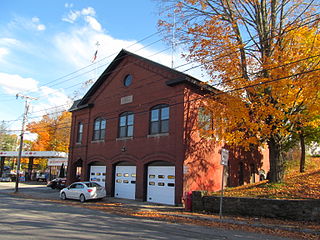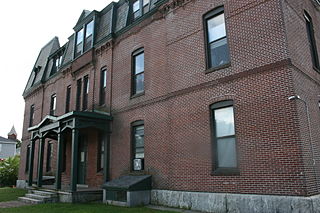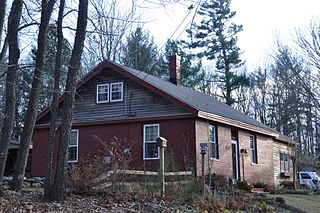Southbridge-Sargent Manufacturing District | |
 | |
| Location | Southbridge, Sargent, and Gold Sts., Worcester, Massachusetts |
|---|---|
| Coordinates | 42°15′15″N71°48′23″W / 42.25417°N 71.80639°W Coordinates: 42°15′15″N71°48′23″W / 42.25417°N 71.80639°W |
| Built | 1866 |
| Architect | Unknown |
| Architectural style | Second Empire, Other |
| MPS | Worcester MRA |
| NRHP reference # | 80000534 [1] |
| Added to NRHP | March 05, 1980 |
The Southbridge-Sargent Manufacturing District encompasses a collection of three 19th-century factory buildings near a historically important railroad junction in southern Worcester, Massachusetts. They were built near the intersection of Sargent and Gold Streets, just south of Southbridge Street. The location is close to a junction of three major railroads: the Boston and Albany, the Norwich and Worcester, and the New York, New Haven, and Hartford. The area was once a major industrial part of the city, but has lost many of its historic factory buildings in the 20th century. [2]

Worcester is a city in, and the county seat of, Worcester County, Massachusetts, United States. Named after Worcester, England, as of the 2010 Census the city's population was 181,045, making it the second most populous city in New England after Boston. Worcester is located approximately 40 miles (64 km) west of Boston, 50 miles (80 km) east of Springfield and 40 miles (64 km) north of Providence. Due to its location in Central Massachusetts, Worcester is known as the "Heart of the Commonwealth", thus, a heart is the official symbol of the city. However, the heart symbol may also have its provenance in lore that the Valentine's Day card, although not invented in the city, was mass-produced and popularized by Esther Howland who resided in Worcester.

The Boston and Albany Railroad was a railroad connecting Boston, Massachusetts to Albany, New York, later becoming part of the New York Central Railroad system, Conrail, and CSX Transportation. The line is currently used by CSX for freight. Passenger service is still operated on the line by Amtrak, and by the MBTA Commuter Rail system, which owns and uses the section east of Worcester as their Framingham/Worcester Line.

The New York, New Haven and Hartford Railroad, commonly known as the New Haven, was a railroad that operated in the New England region of the United States from 1872 to 1968, dominating the region's rail traffic for the first half of the 20th century.
The most significant building in the district is the former Sargent Card-Clothing Factory, 300 Southbridge Street. This Second Empire three story brick structure, built in 1866, is one of the oldest surviving factory buildings in the city. It was built for the Sargent brothers, leading manufacturers of card making machinery, and is built to a plan that was used, with some modifications, for later purpose-built factory buildings in the city. [2]
The Rice and Griffin Factory at 5 Sargent Street was built c. 1890. It was originally three stories with a pitched gable roof, but the roof was removed and a fourth floor added. Rice and Griffin was founded in 1866, and was listed at that address from 1872 until 1905. The company's principal business was the production of architectural building parts, and it is probable that their products decorated a significant number of Worcester's Victorian houses. [2]
The third factory, at 125 Gold Street, was built c. 1892 for the Whitcomb Manufacturing Company. It is a utilitarian two story brick building. The company began operations in space rented at 5 Sargent Street before building these premises. The company produced metalworking machinery, including planers, shearing and punching tools. [2]
Planing is a manufacturing process of material removal in which the workpiece reciprocates against a stationary cutting tool producing a plane or sculpted surface. Planing is analogous to shaping. The main difference between these two processes is that in shaping the tool reciprocates across the stationary workpiece. Planing motion is the opposite of shaping. Both planing and shaping are rapidly being replaced by milling.
Shearing, also known as die cutting, is a process which cuts stock without the formation of chips or the use of burning or melting. Strictly speaking, if the cutting blades are straight the process is called shearing; if the cutting blades are curved then they are shearing-type operations. The most commonly sheared materials are in the form of sheet metal or plates, however rods can also be sheared. Shearing-type operations include: blanking, piercing, roll slitting, and trimming. It is used in metalworking and also with paper and plastics.

Punching is a forming process that uses a punch press to force a tool, called a punch, through the workpiece to create a hole via shearing. Punching is applicable to a wide variety of materials that come in sheet form, including sheet metal, paper, vulcanized fibre and some forms of plastic sheet. The punch often passes through the work into a die. A scrap slug from the hole is deposited into the die in the process. Depending on the material being punched this slug may be recycled and reused or discarded.
The district was listed on the National Register of Historic Places in 1980. [1]

The National Register of Historic Places (NRHP) is the United States federal government's official list of districts, sites, buildings, structures, and objects deemed worthy of preservation for their historical significance. A property listed in the National Register, or located within a National Register Historic District, may qualify for tax incentives derived from the total value of expenses incurred preserving the property.























